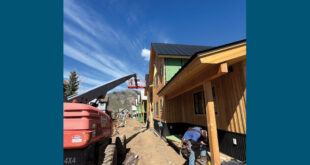Planning for a future without “man camps”
After offering up a 960-acre, family-owned in-holding in the middle of the Fossil Ridge Recreation Area for trade to the federal government, longtime Gunnison resident Butch Clark knew he was in for a wait.
He hasn’t been disappointed. But a letter from Senators Michael Bennett and Mark Udall asking that Congress include the Fossil Ridge Parcel in the Forest Service’s acquisitions budget for 2013 has given Clark a reason to hope that wheels are turning.
The senators’ letter to the Secretary of Agriculture named three projects around the state for Federal Land and Water Conservation Fund money, including Clark’s big-picture plan to make room for affordable, temporary housing in the county. When he donated the land to the Gunnison Valley Housing Foundation last year, Clark was making a suggestion that couldn’t be ignored. He was also planning for the future.
“We are very fond of the property and we want it to be preserved as it is for generations. And we also know that in rural western communities, finding space to build affordable housing can be a problem and we think both concerns can be addressed with this arrangement,” Clark says.
The arrangement has grown more complicated over time. What started as a plan to trade the federal government one piece of land for another has turned into an unsurprising discussion about value, need and location.
The senators’ letter could put the Fossil Ridge Parcel on the Forest Service’s radar, but Housing Authority director KT Gazunis admits, “These things can take years and if it weren’t funded [in 2013], it would be put in the queue.”
Gazunis said the Gunnison Valley Housing Foundation (GVHF), which was created to guide Clark’s land through the federal process, has gotten board approval to sell pieces of the Fossil Ridge Parcel when the opportunity arises, instead of waiting for a single transaction.
That could happen, hypothetically, if someone, somewhere wanted to buy a piece of Forest Service land. In that case, the buyer could purchase a bit of the Fossil Ridge Parcel from the Trust for Public Lands, which is holding the title for the land in receivership for GVHF, which could then trade the purchase property for the Forest Service land that got the process started.
Clark says, “I was pushing to trade acre for acre for affordable housing but the Forest Service has to trade value for value.” That policy led to the collapse of a (past) deal that included an abandoned, privately owned mine near Powderhorn, he said. “They feel the acreage in Lost Canyon is worth a lot more than messed-up forestland. So [a trade] could end up being more than acre for acre.”
Gazunis added, “When we started it was to trade and now we’re willing to do a combination of sale and trade. Or we may end up selling everything instead.”
But the impending listing under the Endangered Species Act of the Gunnison sage grouse could also have an impact on any future federal land deals. A survey of the property is already under way to determine what resources are there, from wetlands to wildlife habitats. Gazunis said the survey would “strengthen our representation of the value of the property.”
The slow start to the land exchange is also helping the GVHF plan for what it would like to see done with the property, which is surrounded by public lands popular with cross-country skiers. According to Gazunis, the public benefit of having the land, with its historic cabin, open for that use is something the GVHF board would like to see maintained with a 15-acre cutout that would remain open as a “Nordic recreation area.”
On the land acquired in the trade, Clark envisions a community made to replace the “man camps” that historically sprung up with big industrial operations across the west. His vision includes temporary, and affordable, housing that will be mobile and easy to remove when the project is complete. To make the community livable and more sustainable, Clark would like to see his land traded for something near a population center and public transportation.
And the future Clark has envisioned seems to get closer every day. He says there are a number of projects coming through the county that could draw in a workforce large enough to require a town away from town.
With the molybdenum mine on Mt. Emmons on the back burner, Clark says, rare earth mines being considered near Powderhorn and geothermal development near Tomichi Dome could still bring a need for additional housing to the county.
But it is the first grumblings of a molybdenum mine being developed near White Pine that has piqued Clark’s interest the most.
“The mining that’s being proposed above White Pine, at the scale that’s been talked about at 60,000 tons [of ore] per day, is twice the size of AMAX at its biggest,” he said, referring to the Climax Molybdenum Company operation near Leadville. “AMAX was working about 8,000 people per day.”
With the potential for an operation that size possibly coming to Gunnison County, Clark hopes the land exchange will move forward sooner rather than later.
“The process has slowed, but it isn’t exactly stuck and that’s why I appreciate the senators pushing it forward,” Clark says, “because it takes a lot longer for communities to get their act together and cope with the operations than it does for those operations to move in.”
 The Crested Butte News Serving the Gunnison Valley since 1999
The Crested Butte News Serving the Gunnison Valley since 1999

